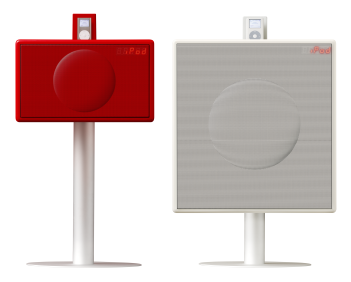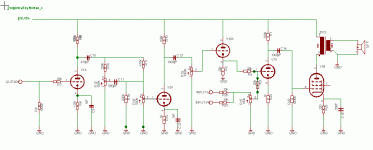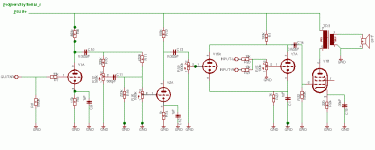Inspired by the nice Ipod-speakers of Geneva Labs:

I want to make something that looks a bit similar accepting one stereo input (mp3player) and one guitar. Design goals:
-monosound
-8-12" sensitive fullrangespeaker, "openback" or enclosed box
-el84 single ended output
-one 12ax7 = 2 gain stages for guitar (gain- ja single-knob-tone controls)
-guitar distortion from preamp, the power amp part should be designed for low distortion
-capability to listen to mp3 and guitar simultaneously (mixer)
-maximum simplicity, miminum amount of knobs
Now I don't have much experience of circuit design but I have drawn something in the lines of what I'm aiming at. The part numbering doesn't follow any logic. Sorry for that. It's a user-software compability issue...
Comments appreciated! I'm very unsure about the "mixer" part of the circuit.
EDIT: found an error: need to add a cap after the cathode follower...

I want to make something that looks a bit similar accepting one stereo input (mp3player) and one guitar. Design goals:
-monosound
-8-12" sensitive fullrangespeaker, "openback" or enclosed box
-el84 single ended output
-one 12ax7 = 2 gain stages for guitar (gain- ja single-knob-tone controls)
-guitar distortion from preamp, the power amp part should be designed for low distortion
-capability to listen to mp3 and guitar simultaneously (mixer)
-maximum simplicity, miminum amount of knobs
Now I don't have much experience of circuit design but I have drawn something in the lines of what I'm aiming at. The part numbering doesn't follow any logic. Sorry for that. It's a user-software compability issue...
Comments appreciated! I'm very unsure about the "mixer" part of the circuit.
EDIT: found an error: need to add a cap after the cathode follower...
Attachments
All the mixers I have ever seen used 220k+ resistors. Look at some old PA schematics for how to sum inputs. I might replace R20 and R21 with a 500k-1M linear pot, with the output off the wiper. Then you'd be able to get a kind of mono balance control, many tracks are not equally mixed. I'm not sure what you have wouldn't work though, because I've never tried it. I would use a larger plate load on the first stage and/or a smaller cathode resistor for more preamp distortion (since that's all before the ipod). I'd examine old plexi and tweed schematics for some values, but there's a range of variance available in a guitar amp. I'd add a switch in front of R4 which allows the cathode followers output to be either grounded or resistively loaded or something so that you don't get the guitar preamp noise when you just want to listen to the ipod. I *think* you might want larger coupling caps in many of those stages, (1000pf = 1nf = .01 uf? bad at math...marshall's used .022u for the first stage in many cases, the 470pf may be a tad bright). There's probably other tips, but that's what catches my eye. I don't see any of the voltages so it's hard to calculate the values, but you can either use an RC-coupled data chart for 12ax7s or the good old guess and check approach to make it work better. Personally though, I like SE El84 power amp distortion a lot better than 12ax7 distortion, ymmv.
Thank you for your reply!
You are right about the guitar preamp. It needs further investigation.
I googled a bit on tube mixers and found an old tubecad article:
http://www.tubecad.com/april_may2001/page22.html
On the next page: http://www.tubecad.com/april_may2001/page23.html
...there is a schematic with a triode for each input but with common anodes and cathodes. The tubecad circuit is unity gain, but why couldn't the mixing stages also be gain stages. Please have a look at my new version. Do you think this would work? Could the mixer stage of the guitar amp part even be a distorting stage even if it is connected to the clean gainstage of the ipod?
I agree that power tube distortion sounds better than 12AX7 distortion. Depending on what kind of circuit I end up with I could try different kind of tubes, but ofcourse the guitardistortion here will allways have to be preamp distortion.
You are right about the guitar preamp. It needs further investigation.
I googled a bit on tube mixers and found an old tubecad article:
http://www.tubecad.com/april_may2001/page22.html
On the next page: http://www.tubecad.com/april_may2001/page23.html
...there is a schematic with a triode for each input but with common anodes and cathodes. The tubecad circuit is unity gain, but why couldn't the mixing stages also be gain stages. Please have a look at my new version. Do you think this would work? Could the mixer stage of the guitar amp part even be a distorting stage even if it is connected to the clean gainstage of the ipod?
I agree that power tube distortion sounds better than 12AX7 distortion. Depending on what kind of circuit I end up with I could try different kind of tubes, but ofcourse the guitardistortion here will allways have to be preamp distortion.
Attachments
Yes, the mixer gain have plenty of gain, and yes, the guitar side of it will distort.thomsva said:The tubecad circuit is unity gain, but why couldn't the mixing stages also be gain stages. Please have a look at my new version. Do you think this would work? Could the mixer stage of the guitar amp part even be a distorting stage even if it is connected to the clean gainstage of the ipod?
However, you may find that the guitar sound is way louder than the MP3! You might want to split R1 into two, say both 47k. The MP3 triode sees the full 94k, but the guitar triode's anode (V16A) is connected to the junction of the two resistors, so sees only 47k. V16A also needs a gid stopper (10k to 100k say) or you're pretty much guarenteed to get blocking distortion.
Otherwise your schem looks good.
- Status
- This old topic is closed. If you want to reopen this topic, contact a moderator using the "Report Post" button.

